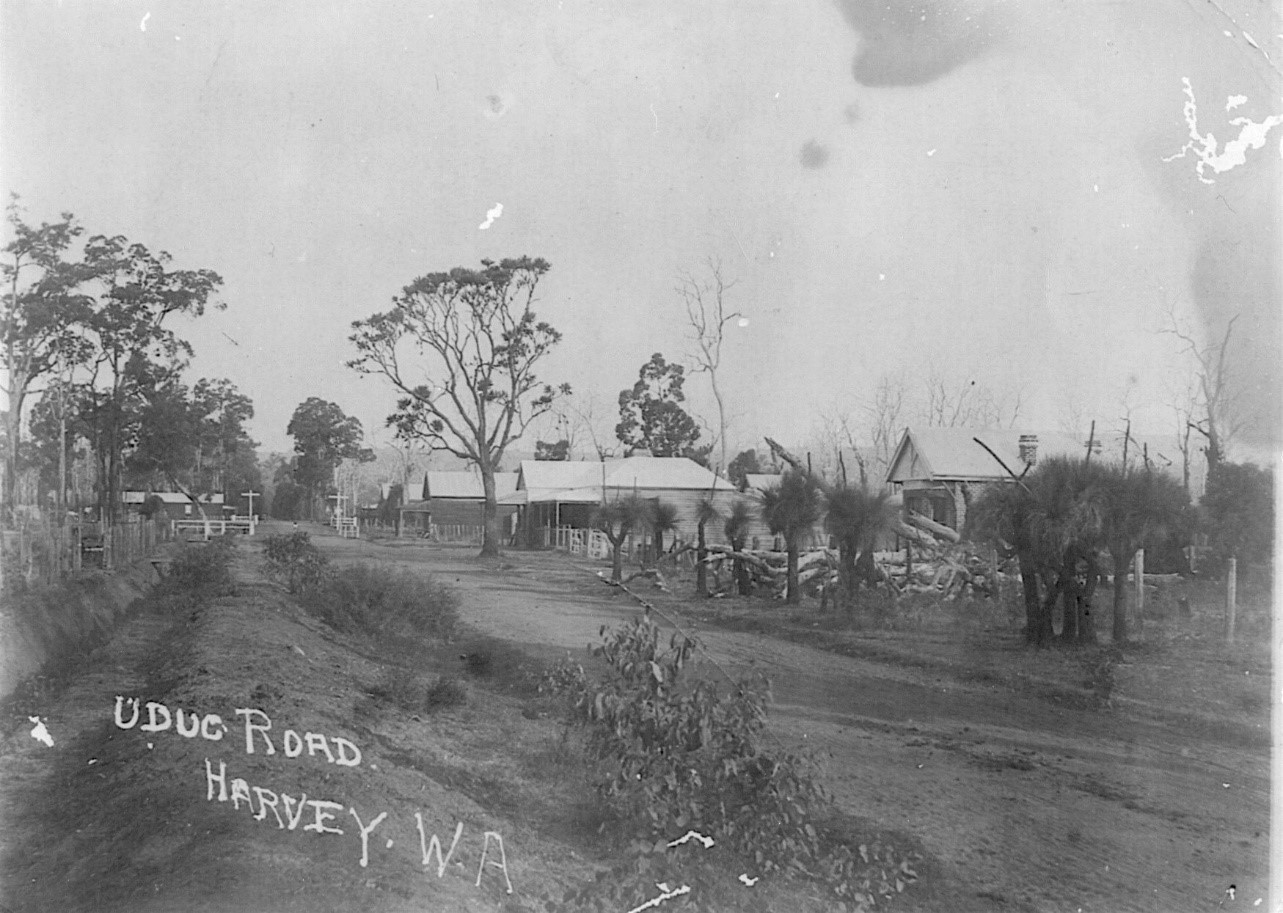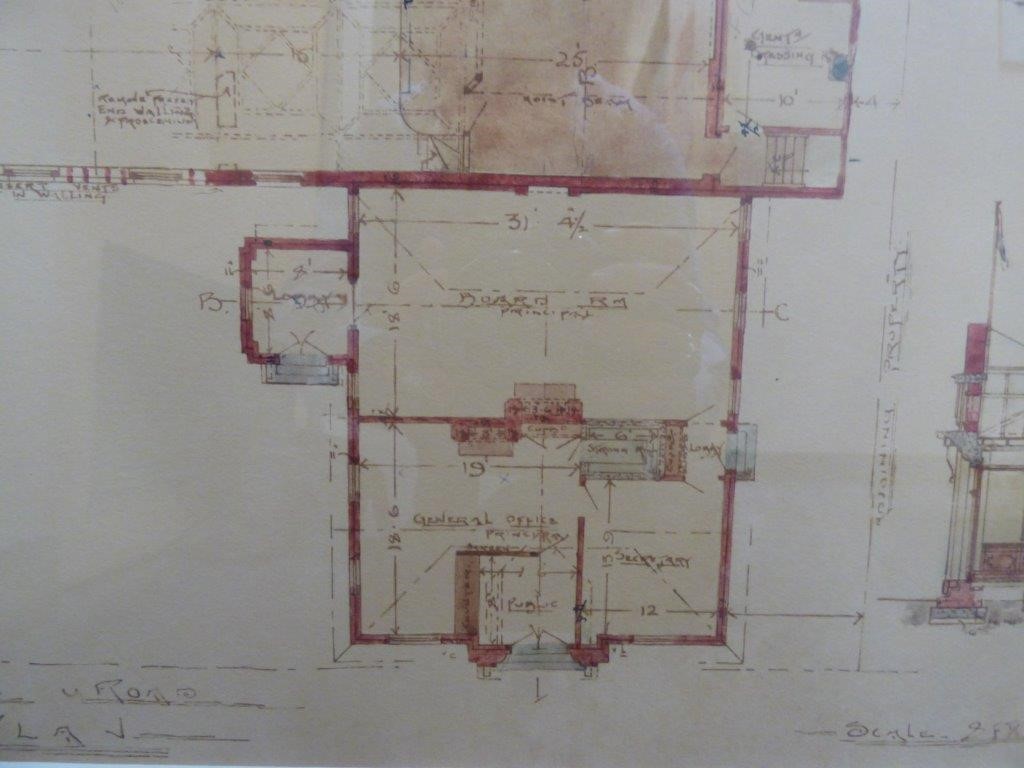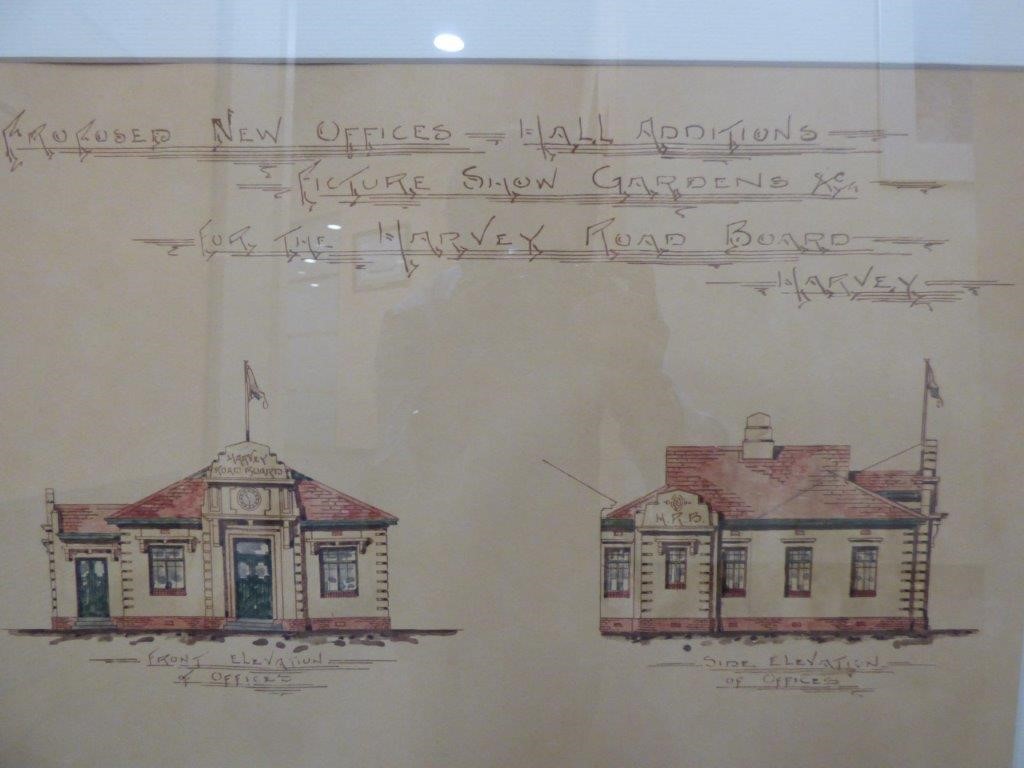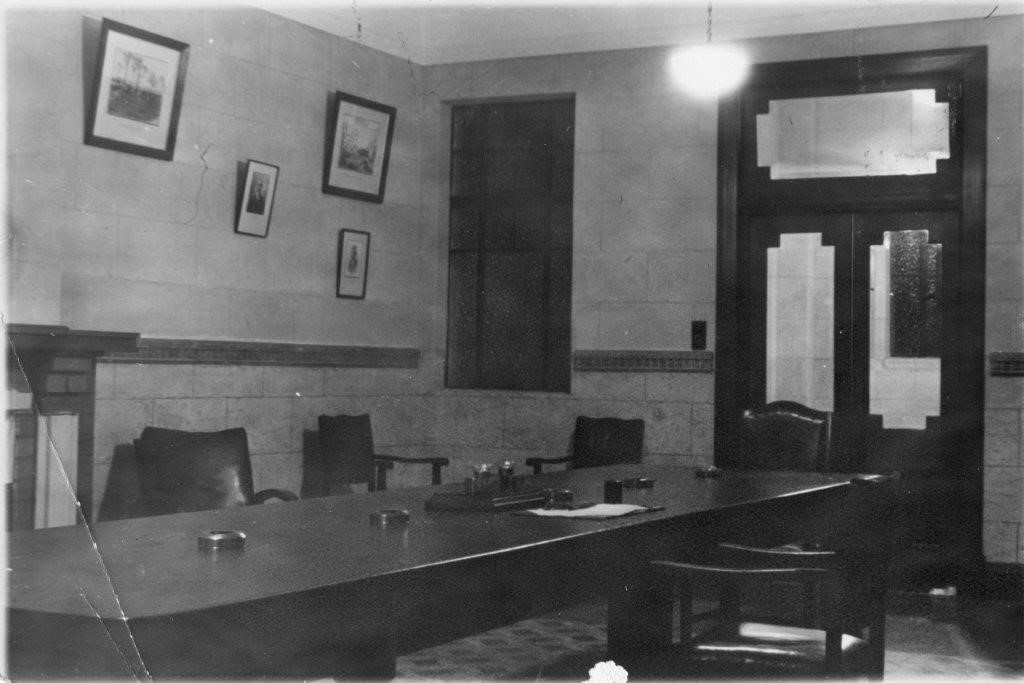By Heather Wade, 2020
The Shire of Harvey administration building is prominent in the town as is the Harvey Hall which abuts it. The 1935 purpose-built Harvey Road Board office has been retained and expanded as the Shire has grown.
Shire of Harvey Administration Building, 2019.
The current Shire of Harvey was initially part of the Wellington Road Board which stretched from Capel to Wagerup. The Perth-Bunbury railway constructed in 1893 helped to open up the district. The Wellington Road Board area became too large to service the needs of its growing population so it was split in two. The Brunswick District Road Board held its first election in 1895 when William Reading, William Marriott, David Marriott, JH Logue, AF Clifton, RH Rose Jnr and Arthur Perren were elected. At the first Board meeting on Tuesday 12 February 1895, held at the Brunswick Agricultural Hall, it was ‘resolved to hold monthly meetings in Brunswick and quarterly meetings in Harvey as soon as a suitable building for the purpose is erected.’[1] Meetings were held in Harvey in June and September but no place given, however the November meeting was held at the Mission Hall as that had opened on Sunday, 20 September.[2] Mr James Henry (or Harcourt) Dixon was appointed Secretary to the Board on 20 February 1895[3] and operated from his business premises in Bunbury as the position was only part-time.[4] However, the Mission Hall and the Brunswick Agricultural Hall were listed as places where tenders would be received. From February 1896 meetings were held alternately between Brunswick and Harvey[5] until 1907 when it was resolved to meet in Harvey.[6]
No premises of their own
As the Board didn’t have its own premises it was having to make do and sometimes the notices in the newspapers appear comical or show a Board that could not make up its mind! It stayed at the Mission Hall until notice was served in September 1898 that they didn’t wish to use it,[7] but they were back there in January 1899! Meetings were held in the Agricultural Hall after it was built in 1899 but may not have been held there continuously. At the June meeting in 1905 the ‘Secretary was to write to Harvey Agricultural Committee for terms of hire of hall for Board meetings, and if satisfactory future meetings to be held there.’[8] But by September they had changed their mind:
Mr. S. T. Birch moved, and Mr. W. Reading seconded, that two resolutions passed on the 3rd June and 1st of July, namely: “That future meetings of the Board at Harvey be held in the Harvey Agricultural Hall, and “That the offer of the Committee of the Harvey Agricultural Hall be accepted,” be rescinded. Carried. Resolved to hold future meetings at Harvey at the Korijekup Hotel.[9]
In September 1907 ‘a public meeting was held at Harvey and it was agreed that the Road Board should erect offices, [probably with a house], at Harvey at a cost of £500 on a site donated by Messrs. Peet and Co and that the Board should come under Section 7 of the Roads Board Act to enable the Board to borrow the necessary money.[10] Advertisements for the Korijekup Townsite by Peet and Co., date unknown, shows the location as Lot 4 on Uduc Road, west of Young Street as the ‘Road Board Office site.’ The project did not proceed.
Renting a building
Mr F. J. [Francis Joseph] Sanguinetti offered an unfinished brick building near the railway station to the Board for office purposes at 10s. per week on a three years’ lease in April 1908. He was willing to make any small alterations necessary. Mr. Sutton, on behalf of Mrs. Sutton offered the present office [situated at 76 Uduc Road] at 8s. per week which was accepted until Mr Sanguinetti’s building was ready and the three year lease would commence.[11] Mr Sanguinetti’s building is where the car park of the new Puma Service Station is today, on the southern side of Uduc Road.
Looking east towards the railway crossing, the Harvey Road Board office is the first building on the right. Photo: Harvey & Districts Historical Society, Federation Display.
To purchase the current building or build?
In March 1909 although there was time left on the lease, Mr Sanguinetti offered the building for sale for £280.[12] ‘Mr Sutton said at the price at which it was offered it was almost a gift considering the land and the building. The owner was leaving the district and was anxious to dispose of it or such an offer would never have been made.’[13] To purchase, the Board needed financial assistance and a letter was sent to the PWD for clarification.
At the Board meeting in May 1909 members considered two options – whether to build on land Peet & Co would donate or purchase their current office.
At last Saturday’s meeting of the Brunswick Roads Board, a letter was read from Messrs. Peet and Co., offering a piece of land at Harvey to the Roads Board free on condition that a Roads Board office was erected thereon. The Public Works Department also wrote in reply to the communication from the Board, stating the terms under which the Department were prepared to grant money in aid for the provision of Roads Board offices.
The Secretary said that the only condition was that the Board had to forward to the Public Works Department a bank certificate that they had the amount in the Bank before they could get a subsidy of £ for £ for the building. The only thing was that the £150 must be in the Bank. In reply to a question the Secretary said the terms under which the present office could be purchased were £280, cash or £300 on terms.
The Chairman [Reg Driver] said the question was whether they should continue to pay £26 a year rent or buy the premises right out. If they borrowed money the interest would be 7 per cent, so that the biggest interest would be £11. An overdraft at the bank would be 8 per cent. They could contrast this with £26 a year rent. The Secretary said if a few feet were added to the Board room they could raise £10 or £11 a year in rents.
Mr. Becher said it seemed a good proposition for the Board. The building was under offer to the Board but there were several people willing to take it up if the Board did not do so.
The Chairman said they had a lease of the premises for three years, but it was no good paying £26 a year if they could get out of doing so.
Mr. Sutton said they already knew his views on the subject. He thought it was an offer they should accept. He did not think the members would be opposed to their taking a sum out of the general revenue for the purpose. In fact he was convinced ratepayers would applaud their action.
Mr. A. F. Clifton said it was a better proposition to own an office than to rent it. The only question was would they be wise to buy the building or erect their own. He thought himself that the building was too small, and if they bought it it would always be unsatisfactory. He personally was in favour of building. Was there any probability Messrs. Harvey and Hayward giving them an eligible block?
Mr. Beacher: I don’t think the Board has any chance, of getting one. In fact I’m sure it hasn’t.
Mr. Sutton moved that the offer of Mr. Sanguinetti, to sell the Roads Board office for £280 be accepted, and that arrangements be made for an overdraft accordingly. Carried unanimously.[14]
A Ratepayers’ Meeting of the Harvey Road Board[15] was held on Saturday 5 June when about 25 ratepayers and seven Councillors were present to discuss the advisability of purchasing the present offices. The chairman [R. Driver] reiterated that the offices could be bought for £280 and the government would grant £150 which the Board had to match, and the extra £20 was to be spent in additions to the Building. Some people expressed the concern that the building was too small but at the vote, twenty one were in favour of purchase and none opposed it. The members of the Board refrained from voting although they all expressed themselves in favour of the purchase.[16]
Finally, and perhaps with rose coloured glasses it was reported that — On Thursday last, we understand, the purchase of their office at the Harvey was finally concluded by the Harvey Roads Board. The office is centrally situated and should serve all the purposes of the Board for many years to come. At first the question of its purchase aroused some opposition locally, but as the manifold advantages to be gained, both financially and otherwise, were made apparent, the opposition was converted into support.[17]
As noted in the pros and cons for purchasing, the building was used out of hours to generate income. A request in November 1910 by the Independent Order of Oddfellows to hold meetings there was granted on the payment of 3s per meeting.[18] Other organisations used it for similar purposes.
In 1911 an article in the Blackwood Times titled ‘A Roads Board Office De Luxe’ paints a delightful picture of the building and surrounds as well as extolling the virtues of the work done by the councillors.
Perhaps the largest and best appointed Roads Board Office in the Southern portion of this State is the one for the Harvey District Road Board. The Board Hall is of brick, and comprises the large room in which Board meetings are held, the Secretary’s office, a living room, and a lumber room. In the Board room is the large Board table, a press table, chairs for the members, and forms for the accommodation of ratepayers with a special chair for the Chairman. The Secretary’s office is well fitted, containing everything necessary to help the Secretary and Engineer (Mr. Jas. A. Stewart) to efficiently carry out his duties, such as mathematical instruments, drawing table, etc.
There is a lean-to at the back in which firewood, etc., is stored. Well away from the main buildings are the stables, comprising a loose box for the Board’s draught horse, stalls for each of the members’ horses, and a chaff house, all fitted with up to-date appurtenances. Standing in the yard is the Board’s, maintenance cart, which is a solid business-looking vehicle, and eminently suited for the road repairing work it is constantly engaged upon. Planted at the rear of the Board buildings are rows of fruit trees, which are more for ornamentation than reproductiveness, as the youth of the centre never let the fruit come to maturity. These give a very pleasing effect.
The work of the Secretary and Engineer covers a very large area, extending from Wagerup to Brunswick Junction and from the Coast to practically 15 miles east of Harvey. Members travel good distances when attending Board meetings, the Chairman (Mr. R. Driver, J.P.) driving down from Yarloop, 9 miles. Mr. J. E. M. Clifton, of Rosamel, comes in about 14 miles from the Coast. Other members of the Board are— Messrs. Edwin Rose, J.P., (Wedderburn), William J. Sutton, J.P., (near Harvey), Thos. Hayward, jun., J.P., (Wokalup), Algernon F. Clifton, J.P., (Brunswick), F. J. Becher (Harvey), Edward Cook (Cookernup), Arch. Crampton (Harvey), most of whom are resident some distance from Harvey. In addition to being members of the Roads Board, the Harvey Roads Board also takes in the duties of the Harvey Drainage Board, the Harvey Health Board, and also, we believe, the Harvey Cemetery Committee. Though transacting the largest volume of business of any Board practically in the State, the Board only sits once a month, commencing at 9.30 a.m. on the first Saturday in each month and invariably finishing before 12.30. This is due to the judicious Chairmanship of Mr. Driver, and when other members of the Board act in that capacity, the same result is always obtained.[19]
Moving to the Drill Hall
The building remained the Road Board office from 1909 until 1917. A quick succession of events led to moving from the office the Board owned to renting part of the Drill Hall, now known as the Lesser Hall. The Harvey Drill Hall was built in 1915 as part of a Commonwealth Government programme of expansion for training young men during World War 1. The Board probably had outgrown its premises and when the opportunity arose they could solve two problems at once. At the June meeting in 1917 the Board received a request from the Harvey Citrus Society to take over the Hall and Grounds with reimbursement of £750. The Society claimed that the assets were worth £2580. Mr Cook, AE Clifton and the Chairman were tasked to explore the matter and report to the Board. Their recommendation at the next meeting was to take over the assets for £250 and that the mortgage [of £500 used to build the 1914 Hall] from Dr Hayward be also taken over.[20] During WW1 local growers were struggling to overcome problems caused by serious labour shortages and this would have taken its toll on the ageing members who were left in the Society.
Tenders were called in July and it was hoped that a price of £450 would be realised in a sale.
HARVEY ROADS BOARD. TENDERS will be received up to 9.30 a.m. on Saturday, August 4, 1917, for the PURCHASE of HARVEY TOWN LOT No. 3, on which stands the Harvey Road Board offices. The chaff, feed rooms and stables will be removed by the 23rd. All particulars from the Secretary of the Board, Harvey; 5 per cent, deposit to accompany each Tender: balance to be paid on the signing of transfer. No Tender necessarily accepted. T. HAYWARD, Chairman. 20 July I917.
At the September meeting the Secretary reported no offer had been received. He was instructed to rent it if it had not sold and to have the stables erected on the Recreation Ground.[21]
The Board had moved into the Drill Hall and was running its affairs there by 1 December 1917 as the minutes record that ‘the Bd congratulated the Sec on the way the new offices were constructed.’[22]
Two years later at the October meeting of the Board it was reported by the South Western Times that:
A letter was read from the Water Supply Department relative to the sale of the old Road Board office for £400 and requiring certain repairs and renovations to be put in hand. The secretary had replied that the Board would be prepared to undertake the renovations required if the price was raised to £415, and on these terms the sale was concluded.[23]
In early 1924 the Secretary was instructed to have a strong room erected at a cost of approximately £65. The strong room’s position can still be seen from the change in the floorboards in front of the fireplace, and until a few years ago those boards were slightly raised. This and other changes to the building lead to conflict with the landlord – the Commonwealth Government.[24]
NOTICE TO QUIT
HARVEY ROAD BOARD TO FIND A NEW OFFICE.
For several months now matters between the Harvey Road Board and the Defence Department have been strained; voluminous correspondence has passed between the Board, the Commonwealth Solicitors and interested Members of Parliament, but no way has been found out of the difficulty, and now diplomatic relations have been broken off and the Board received notice to quit. The correspondence and discussions at the Board meetings have always been held in camera, but now things have reached the stage when the matter must be made public. The trouble all arose over the erection of a strong room and certain partitions to form offices. These, so the Commonwealth allege, were carried into effect without notice being given, and contrary to clauses in the lease, and have materially reduced the floor space of the building and considerably reduced its use as a drill hall should it ever be required by the military authorities. The Harvey Road Board contends that they have in no way interfered with the utility of the hall, and that there is more than sufficient space for all military requirements of Harvey for many years to come. The matter was referred to Mr. Prowse to see whether he could find a way of avoiding what was, to all intents and purposes, an eviction but the last communication, received by him from the Defence Department clears away all idea of a compromise — the Board must quit. The letter states: “With further reference to your letter of April 2lst referring to the communication received by you from Mr F. J. Becher, Chairman of the Harvey Road Board, relative to the lease by the Commonwealth of the Drill Hall at Harvey, after full consideration I find that I cannot vary the previous decision that the office must be removed. As the lease has approximately 90 years to run it would be very inadvisable to permit any encroachment on the rights of the Commonwealth.” The matter had been considered by the Finance Committee of the Board and their recommendation was that the question should be submitted to a sub-committee and their proposals placed before the next meeting of the Board. This suggestion was adopted.[25]
At the July 1927 meeting it was recorded that ‘A meeting to deal with the office question was then held and it was decided that plans be prepared for new offices the site favoured being on the north side of Drill Hall.[26] A resolution must have been found as the Board remained there until 1935.
New offices
The state of the Harvey Hall and whether it should be repaired or replaced took most of the Road Board’s attention in 1934.[27] It was decided to build and Architects Powell, Cameron and Chisolm designed the new three-roomed Road Board offices and the alterations and additions to the Hall and today their December 1934 drawings can be seen in the foyer of the Shire Offices. Mr J Johnson’s tender of ‘£2,762/10/- for the work was accepted with work expected to begin on 18 March and be completed by 8 July.[28]
Above and below – Architectural drawings by Powell, Cameron and Chisolm showing the Road Board Office which are on display at the Harvey Shire Offices. Photo: Ryan Djanegara.
It was a day of celebration in Harvey on 12 August 1935 when Lieutenant Governor, Sir James Mitchell opened the Hall, the Road Board building and the Harvey River Drainage and Diversion Scheme. About 500 children from the district took part in sports on the recreation ground. Afternoon tea was served in the Hall and in the evening a ‘movie’ ball was held.[29]
Newspaper clippings reworked by Marion Lofthouse for the Federation Display in 2001.
Harvey Road Board offices post 1935. Photo: Harvey and Districts Historical Society, Federation Display.
The Board meeting room. Photo: Harvey and Districts Historical Society, Federation Display.
See also ‘Harvey Halls’ on this website.
[1] Southern Times, 14 February 1895.
[2] Bunbury Herald, 14 Sept 1895. The Methodist Church, also known as the Mission Hall, was situated at the back of ‘Kilrea’ 56 Uduc Road.
[3] Southern Times, 23 February 1895.
[4] On 30 April 1894 Dixon took up the appointment as Secretary of the Wellington Road Board. During the years 1894/95 the Board was broken up into Bunbury, Dardanup and Brunswick Road Boards and Dixon served each of them, sometimes simultaneously, as Secretary. He was the Secretary for the Brunswick Road Board from February 1895 to July 1906. See ‘Thomas Mainwaring (alias John Buchanan) and James Henry (or Harcourt) Dixon, Convicts’ on this website.
[5] Southern Times, Road Board monthly meeting reports.
[6] Marion Lofthouse & Kerry Davis (eds), Shire of Harvey, Proud to be 100, 1895 – 1995 Centennial Book. Shire of Harvey, Harvey, Western Australia, 1995, p. 96.
[7] Bunbury Herald, 10 September 1898.
[8] Southern Times, 10 June 1905.
[9] Southern Times, 21 Sept 1905.
[10] West Australian, 17 September 1907.
[11] Southern Times, 7 April 1908.
[12] Southern Times, 9 March 1909.
[13] Southern Times, 6 April 1909.
[14] Southern Times, 6 May 1909.
[15] On 1 May 1909 at a Regular Meeting of the Board the name was changed from Brunswick Road Board to Harvey Road Board removing confusion as to its headquarters.
[16] Harvey Road Board minutes, 5 June 1909.
[17] Southern Times, 24 July 1909.
[18] Bunbury Herald, 15 Nov 1910.
[19] Blackwood Times, 1 August 1911.
[20] Harvey Road Board minutes, 2 June 1917 & 7 July 1917.
[21] Harvey Road Board minutes, 1 September 1917.
[22] Harvey Road Board minutes, 1 December 1917.
[23] South Western Times, 7 Oct 1919.
[24] South Western Times, 14 June 1927.
[25] South Western Times, 14 June 1927.
[26] Harvey Road board minutes, 11 July 1927.
[27] Shire of Harvey, Proud to be 100, 1895 – 1995 Centennial Book, p. 104.
[28] West Australian, 21 March 1935.
[29] West Australian, 13 August 1935.






